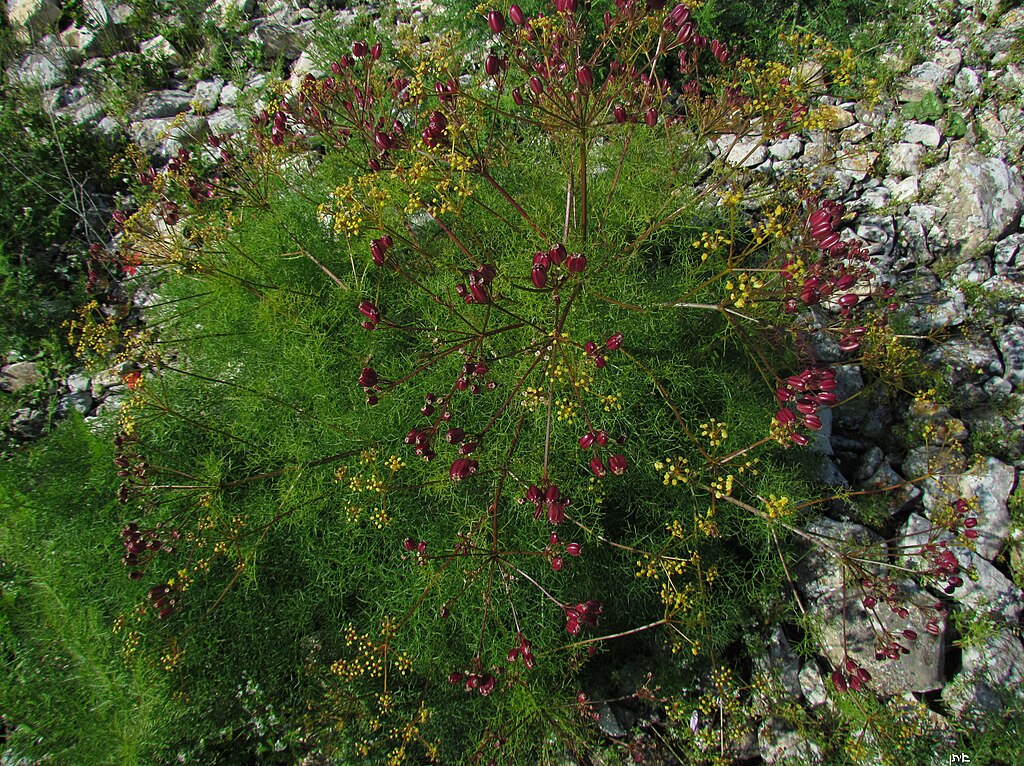Prangos ferulacea (L.) Lindl. - Apiaceae - jashir (persian)
Perennial herb native from East Europe to Western and Central Asia, used in herbal medicine for gastrointestinal disorders.
„A robust, round-shaped, 0.5-1.5 m. tall perennial herbaceous plant. Basal and lower stem leaves to 6 pinnate, 60-80 cm long; leaf lobes linear. Inflorescence 7-15 (-20) rayed, pale yellow. Flowers cover all plant in peak blooming. Fruit corky, elliptical to globose, slightly or not winged, whitish, often pink tinged, 12-25 mm long, 10-15 mm broad.“
[Flora of Israel Online, Prof. Avinoam Danin, 2017] http://flora.org.il/en/plants/prafer/
„The essential oil of Prangos ferulacea (Apiaceae) fruits was obtained by hydrodistillation and analyzed by gas chromatography (GC) and GC-mass spectrometery (MS). Among the 39 identified constituents accounting for 99.99% of the total oil, the major components were chrysanthenyl acetate (26.53%), limonene (19.59%), alpha pinene (19.50%), delta-3-carene (6.56%), mesitaldehyde (6.09), and germacrene-B (3.55%). Antimicrobial activity of the essential oil was investigated against some gram positive and gram negative bacteria. The essential oil of P. ferulacea showed activity against Staphylococus aureus, S. epidermis, Eschrechia coli and
Pseudomonas aeroginosa.“
[Chemical constituents and antibacterial activity of essential oil of Prangos ferulacea (L.) Lindl. fruits., Massumi, M.A., Fazeli, M.R., Alavi, S.H.R., Ajani, Y., Iranian Journal of Pharmaceutical Sciences, Vol.3(3), 2007, 171-176]
http://www.sid.ir/EN/VEWSSID/J_pdf/106720070306.pdf
„The plant’s leaves are used as animal fodder. Its fruits and roots possess biological traits that provide it with the potential to be used for medicinal purposes. The essential oils obtained through hydrodistillation from aerial parts of Prangos ferulacea at the vegetative and flowering stages were analyzed through GC and GC-MS. Thirty-one vs. seven compounds were identified in the vegetative and flowering stages’ oils, respectively. While the essential oil of aerial parts at vegetative stage was dominated by α-pinene (57%), the oil at flowering stage was characterized by (E)-anethol (95.5%).“
[Chemical composition and some allelopathic aspects of essential oils of (Prangos ferulacea L.) Lindl at different stages of growth., Razavi, S.M., Journal of Agricultural Science and Technology, Vol.14(2), 2011, 349-356]
„Osthole is a major component of P. ferulacea acetone extract which is responsible for the relaxant effect of the extract on the rat ileum. On the other hand, the P. ferulacea extract had a potential to increase neuronal contractile response of rat ileum; therefore, if it is going to be used for gastrointestinal spasm, the stimulatory component should be separate. Nevertheless, oshtole has anti-spasmodic action on isolated rat ileum. It is necessary to investigate these effects in vivo. Furthermore, due to predictable anticoagulant properties of osthole as a cumarin derivative, its anticoagulant activity must be considered against its use as an antispasmodic drug and its acute and chronic toxicities should be passed before further pharmacological studies.“
[Antispasmodic effects of Prangos ferulacea acetone extract and its main component osthole on ileum contraction., Sadraei, H., Shokoohinia, Y., Sajjadi, S.E., Mozafari, M., Research in pharmaceutical sciences, Vol.8(2), 2013, 137]
http://www.ncbi.nlm.nih.gov/pmc/articles/PMC3764677/
 osthole (7-methoxy-8-(3-methylbut-2-enyl)-2-chromenone)
osthole (7-methoxy-8-(3-methylbut-2-enyl)-2-chromenone)
„P. ferulacea has been used in folk medicine as emulient, carminative, tonic, sedative, antiflatulent, anthelmintic, antibacterial, antispasmodic, and antidiabetic agents. Monoterpenes, sesquiterpenes, coumarines, flavonoids, alkaloids, tannins, saponins, and terpenoids are some important compounds identified in this plant. Previous researches indicated that antioxidant properties of this plant were higher than α-tocopherole (vitamin E) and the main compounds of P. ferulacea in different growth stages were monoterpenes, specially α-pinene, and β-pinene.“
[A review on phytochemistry and pharmacological effects of Prangos ferulacea (L.) Lindl.,Kafash-Farkhad, N., Asadi-Samani, M., Rafieian-Kopaei, M., Life Sci J, Vol.10(8s), 2013, 360-367]
http://www.lifesciencesite.com/lsj/life1008s/057_19281life1008s_360_367.pdf

Prangos ferulacea
CC BY-SA 3.0, Author: Eitan f Wikimedia Commons
